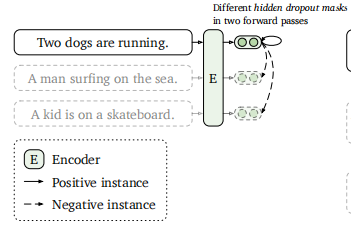1
2
3
4
5
6
7
8
9
10
11
12
13
14
15
16
17
18
19
20
21
22
23
24
25
26
27
28
29
30
31
32
33
34
35
36
37
38
39
40
41
42
43
44
45
46
47
48
49
50
51
52
53
54
55
56
57
58
59
60
61
62
63
64
65
66
67
68
69
70
71
72
73
74
75
76
77
78
79
80
81
82
83
84
85
86
87
88
89
90
91
92
93
94
95
96
97
98
99
100
101
102
103
104
105
106
107
108
109
110
111
112
113
114
115
116
117
118
119
120
121
122
123
124
125
126
127
128
129
130
131
132
133
134
135
136
137
| def cl_forward(cls,
encoder,
input_ids=None,
attention_mask=None,
token_type_ids=None,
position_ids=None,
head_mask=None,
inputs_embeds=None,
labels=None,
output_attentions=None,
output_hidden_states=None,
return_dict=None,
mlm_input_ids=None,
mlm_labels=None,
):
return_dict = return_dict if return_dict is not None else cls.config.use_return_dict
ori_input_ids = input_ids
batch_size = input_ids.size(0)
num_sent = input_ids.size(1)
mlm_outputs = None
input_ids = input_ids.view((-1, input_ids.size(-1)))
attention_mask = attention_mask.view((-1, attention_mask.size(-1)))
if token_type_ids is not None:
token_type_ids = token_type_ids.view((-1, token_type_ids.size(-1)))
outputs = encoder(
input_ids,
attention_mask=attention_mask,
token_type_ids=token_type_ids,
position_ids=position_ids,
head_mask=head_mask,
inputs_embeds=inputs_embeds,
output_attentions=output_attentions,
output_hidden_states=True if cls.model_args.pooler_type in ['avg_top2', 'avg_first_last'] else False,
return_dict=True,
)
if mlm_input_ids is not None:
mlm_input_ids = mlm_input_ids.view((-1, mlm_input_ids.size(-1)))
mlm_outputs = encoder(
mlm_input_ids,
attention_mask=attention_mask,
token_type_ids=token_type_ids,
position_ids=position_ids,
head_mask=head_mask,
inputs_embeds=inputs_embeds,
output_attentions=output_attentions,
output_hidden_states=True if cls.model_args.pooler_type in ['avg_top2', 'avg_first_last'] else False,
return_dict=True,
)
pooler_output = cls.pooler(attention_mask, outputs)
pooler_output = pooler_output.view((batch_size, num_sent, pooler_output.size(-1)))
if cls.pooler_type == "cls":
pooler_output = cls.mlp(pooler_output)
z1, z2 = pooler_output[:,0], pooler_output[:,1]
if num_sent == 3:
z3 = pooler_output[:, 2]
if dist.is_initialized() and cls.training:
if num_sent >= 3:
z3_list = [torch.zeros_like(z3) for _ in range(dist.get_world_size())]
dist.all_gather(tensor_list=z3_list, tensor=z3.contiguous())
z3_list[dist.get_rank()] = z3
z3 = torch.cat(z3_list, 0)
z1_list = [torch.zeros_like(z1) for _ in range(dist.get_world_size())]
z2_list = [torch.zeros_like(z2) for _ in range(dist.get_world_size())]
dist.all_gather(tensor_list=z1_list, tensor=z1.contiguous())
dist.all_gather(tensor_list=z2_list, tensor=z2.contiguous())
z1_list[dist.get_rank()] = z1
z2_list[dist.get_rank()] = z2
z1 = torch.cat(z1_list, 0)
z2 = torch.cat(z2_list, 0)
cos_sim = cls.sim(z1.unsqueeze(1), z2.unsqueeze(0))
if num_sent >= 3:
z1_z3_cos = cls.sim(z1.unsqueeze(1), z3.unsqueeze(0))
cos_sim = torch.cat([cos_sim, z1_z3_cos], 1)
labels = torch.arange(cos_sim.size(0)).long().to(cls.device)
loss_fct = nn.CrossEntropyLoss()
if num_sent == 3:
z3_weight = cls.model_args.hard_negative_weight
weights = torch.tensor(
[[0.0] * (cos_sim.size(-1) - z1_z3_cos.size(-1)) + [0.0] * i + [z3_weight] + [0.0] * (z1_z3_cos.size(-1) - i - 1) for i in range(z1_z3_cos.size(-1))]
).to(cls.device)
cos_sim = cos_sim + weights
loss = loss_fct(cos_sim, labels)
if mlm_outputs is not None and mlm_labels is not None:
mlm_labels = mlm_labels.view(-1, mlm_labels.size(-1))
prediction_scores = cls.lm_head(mlm_outputs.last_hidden_state)
masked_lm_loss = loss_fct(prediction_scores.view(-1, cls.config.vocab_size), mlm_labels.view(-1))
loss = loss + cls.model_args.mlm_weight * masked_lm_loss
if not return_dict:
output = (cos_sim,) + outputs[2:]
return ((loss,) + output) if loss is not None else output
return SequenceClassifierOutput(
loss=loss,
logits=cos_sim,
hidden_states=outputs.hidden_states,
attentions=outputs.attentions,
)
|

